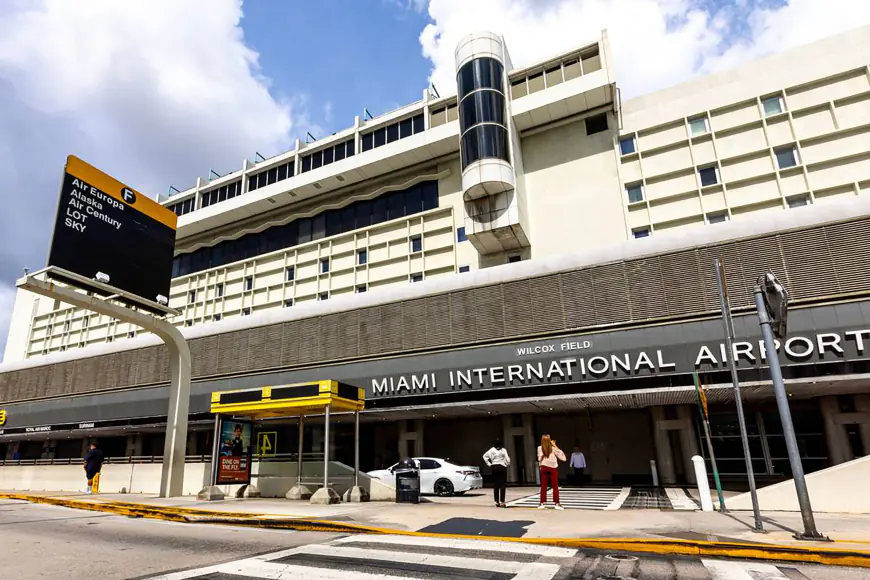MIA's new $6M security system features laser walls and infrared cameras
Miami International Airport (MIA) is getting a new security system, featuring infrared cameras and laser walls, that promises to identify and respond to airport perimeter breaches in real time. The new perimeter intrusion detection system, or PIDS, uses advanced fiber-optic sensors, video surveillance and analytics, laser walls, and ground-based radar to monitor the airport’s perimeter, “enabling quicker and more effective responses to security breaches,” a news release details. MIA was chosen by the Transportation Security Administration as the first test site for the $6 million program, and depending on how it goes, could be replicated at airports nationwide. San Jose Airport in California would be next. “The safety and security of our visitors and employees are always our top priorities, which is why I am so proud to see MIA be the first test site for TSA’s newest security technology,” said Miami-Dade County Mayor Daniella Levine Cava. “Congratulations to the MIA team for leading the way in adopting solutions that improve passenger safety and set new standards for the aviation industry.” So far, 60 cameras have been installed, covering half of the airport perimeter. The Miami-Dade Aviation Department “will fund implementation around the remainder of the airport’s fence line over the next two years,” the news release states. One of the highlights of the new system is its ability to detect breaches over long distances. Jim Bamberger, TSA Director of Multimodal Capabilities and Public Areas, explained that “depending on how close the cameras zoom in, a person located 500 feet away can be seen as clearly as if they were 50 feet away.” In addition, all cameras feature thermal vision, allowing continuous surveillance even in low visibility conditions or at night. The system is composed of panels that, at first glance, might appear to be solar, but are actually part of motion detection technology. The system is directly connected to a monitoring center, where specialized personnel will monitor the cameras and authorities could respond quickly in the event of a breach. The initiative coincides with ongoing expansion work at the airport, with an investment reaching $9 billion, aimed at modernizing infrastructure and improving service.

Miami International Airport (MIA) is getting a new security system, featuring infrared cameras and laser walls, that promises to identify and respond to airport perimeter breaches in real time.
The new perimeter intrusion detection system, or PIDS, uses advanced fiber-optic sensors, video surveillance and analytics, laser walls, and ground-based radar to monitor the airport’s perimeter, “enabling quicker and more effective responses to security breaches,” a news release details.
MIA was chosen by the Transportation Security Administration as the first test site for the $6 million program, and depending on how it goes, could be replicated at airports nationwide. San Jose Airport in California would be next.
“The safety and security of our visitors and employees are always our top priorities, which is why I am so proud to see MIA be the first test site for TSA’s newest security technology,” said Miami-Dade County Mayor Daniella Levine Cava. “Congratulations to the MIA team for leading the way in adopting solutions that improve passenger safety and set new standards for the aviation industry.”
So far, 60 cameras have been installed, covering half of the airport perimeter.
The Miami-Dade Aviation Department “will fund implementation around the remainder of the airport’s fence line over the next two years,” the news release states.
One of the highlights of the new system is its ability to detect breaches over long distances.
Jim Bamberger, TSA Director of Multimodal Capabilities and Public Areas, explained that “depending on how close the cameras zoom in, a person located 500 feet away can be seen as clearly as if they were 50 feet away.”
In addition, all cameras feature thermal vision, allowing continuous surveillance even in low visibility conditions or at night.
The system is composed of panels that, at first glance, might appear to be solar, but are actually part of motion detection technology.
The system is directly connected to a monitoring center, where specialized personnel will monitor the cameras and authorities could respond quickly in the event of a breach.
The initiative coincides with ongoing expansion work at the airport, with an investment reaching $9 billion, aimed at modernizing infrastructure and improving service.
What's Your Reaction?









































































































